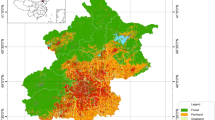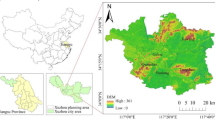Abstract
The construction of an urban green network is increasingly recognized as an effective spatial approach to counteract landscape fragmentation through landscape connectivity conservation. Despite the growing awareness of the importance of “spatial scale”, how to identify critical spatial thresholds and evaluate the consequential ecological effects of spatial scales on the landscape connectivity of urban green network, remains a significant challenge. We examined the effects of spatial scale on the landscape connectivity of urban green networks by detecting critical stepping-stone patches and landscape corridors that maximizes the conservational effectiveness of urban green networks. Our study area is located in the central area of Beijing, China, with a monsoon-influenced humid continental climate. We proposed a graph-based percolation model to simulate the percolation patterns and processes of the landscape connectivity of the urban green network in Beijing. The bond and site percolation models were used to identify critical spatial thresholds in core greenspace patches and landscape dispersal corridors by monitoring the spatial feedback patterns within and across the levels of node, cluster and network. Our study revealed that the landscape connectivity of urban green network exhibited multiple sudden state transitions against percolations. The percolation simulation also demonstrated that the landscape connectivity patterns display divergent ecological patterns and processes across nodal, cluster and network levels. Additionally, the results also identified the existence of critical spatial thresholds, at which urban green network becomes drastically fragmented if such critical “stepping-stone” patches and corridors were destroyed.





Similar content being viewed by others
References
Adriaensen F, Chardon JP, De Blust G, Swinnen E, Villalba S, Gulinck H, Matthysen E (2003) The application of ‘least-cost’ modelling as a functional landscape model. Landsc Urban Plan 64(4):233–247. https://doi.org/10.1016/S0169-2046(02)00242-6
Balbi M, Petit EJ, Croci S, Nabucet J, Georges R, Madec L, Ernoult A (2019) Ecological relevance of least cost path analysis: an easy implementation method for landscape urban planning. J Environ Manage 244:61–68. https://doi.org/10.1016/j.jenvman.2019.04.124
Beijing Statistics Bureau (2020) Beijing statistical yearbook. China Statistics Press, Beijing
Brooks CP (2003) A scalar analysis of landscape connectivity. Oikos 102(2):433–439. https://www.jstor.org/stable/3548048
Bunn AG, Urban DL, Keitt TH (2000) Landscape connectivity: a conservation application of graph theory. J Environ Manag 59(4):265–278. https://doi.org/10.1006/jema.2000.0373
Cumming GS, Olsson P, Chapin FS, Holling CS (2013) Resilience, experimentation, and scale mismatches in social-ecological landscapes. Landsc Ecol 28(6):1139–1150. https://doi.org/10.1007/s10980-012-9725-4
da Costa RA, Dorogovtsev SN, Goltsev AV, Mendes JFF (2010) Explosive percolation transition is actually continuous. Phys Rev Lett 105(25):255701. https://doi.org/10.1103/PhysRevLett.105.255701
Damschen EI, Haddad NM, Orrock JL, Tewksbury JJ, Levey DJ (2006) Corridors increase plant species richness at large scales. Science 313(5791):1284–1286. https://doi.org/10.1126/science.1130098
Fahrig L (1992) Relative importance of spatial and temporal scales in a patchy environment. Theor Popul Biol 41(3):300–314. https://doi.org/10.1016/0040-5809(92)90031-N
Ferrari JR, Lookingbill TR, Neel MC (2007) Two measures of landscape-graph connectivity: assessment across gradients in area and configuration. Landsc Ecol 22(9):1315–1323. https://doi.org/10.1007/s10980-007-9121-7
Forman RT, Godron M (1986) Landscape ecology. Wiley, New York
Gardner RH, Gustafson EJ (2004) Simulating dispersal of reintroduced species within heterogeneous landscapes. Ecol Model 171(4):339–358. https://doi.org/10.1016/j.ecolmodel.2003.08.008
Gardner RH, O’Neill RV, Turner MG, Dale VH (1989) Quantifying scale-dependent effects of animal movement with simple percolation models. Landsc Ecol 3(3–4):217–227. https://doi.org/10.1007/BF00131540
Haddad NM, Brudvig LA et al (2015) Habitat fragmentation and its lasting impact on Earth’s ecosystems. Science 1(2):e1500052. https://doi.org/10.1126/sciadv.1500052
Hermoso V, Morán-Ordóñez A, Lanzas M, Brotons L (2020) Designing a network of green infrastructure for the EU. Landsc Urban Plan 196:103732. https://doi.org/10.1016/j.landurbplan.2019.103732
Herrera LP, Sabatino MC, Jaimes FR, Saura S (2017) Landscape connectivity and the role of small habitat patches as stepping stones: an assessment of the grassland biome in South America. Biodivers Conserv 26:3465–3479. https://doi.org/10.1007/s10531-017-1416-7
Kang S, Kim JO (2015) Morphological analysis of green infrastructure in the Seoul metropolitan area, South Korea. Landsc Ecol Eng 11(2):259–268. https://doi.org/10.1007/s11355-014-0268-5
Keitt TH, Urban DL, Milne BT (1997) Detecting critical scales in fragmented landscapes. Conserv Ecol 1(1):1–13. https://www.jstor.org/stable/26271642
Kindlmann P, Burel F (2008) Connectivity measures: a review. Landsc Ecol 23(8):879–890. https://doi.org/10.1007/s10980-008-9245-4
Klinga P, Mikoláš M, Smolko P, Tejkal M, Höglund J, Paule L (2019) Considering landscape connectivity and gene flow in the Anthropocene using complementary landscape genetics and habitat modelling approaches. Landsc Ecol 34(3):521–536. https://doi.org/10.1007/s10980-019-00789-9
Knaapen JP, Scheffer M, Harms B (1992) Estimating habitat isolation in landscape planning. Landsc Urban Plan 23(1):1–16. https://doi.org/10.1016/0169-2046(92)90060-D
Kong F, Yin H, Nakagoshi N, Zong Y (2010) Urban green space network development for biodiversity conservation: identification based on graph theory and gravity modeling. Landsc Urban Plan 95(1–2):16–27. https://doi.org/10.1016/j.landurbplan.2009.11.001
Kwon OS, Kim JH, Ra JH (2021) Landscape ecological analysis of green network in urban area using circuit theory and least-cost path. Land 10(8):847. https://doi.org/10.3390/land10080847
Laliberté J, St-Laurent MH (2020) Validation of functional connectivity modeling: the Achilles’ heel of landscape connectivity mapping. Landsc Urban Plan 202:103878. https://doi.org/10.1016/j.landurbplan.2020.103878
Li M, Liu RR, Lü L, Hu MB, Xu S, Zhang YC (2021) Percolation on complex networks: theory and application. Phys Rep 907:1–68. https://doi.org/10.1016/j.physrep.2020.12.003
Liu S, Yin Y, Li J, Cheng F, Dong S, Zhang Y (2018) Using cross-scale landscape connectivity indices to identify key habitat resource patches for Asian elephants in Xishuangbanna, China. Landsc Urban Plan 171:80–87. https://doi.org/10.1016/j.landurbplan.2017.09.017
Luque S, Saura S, Fortin MJ (2012) Landscape connectivity analysis for conservation: insights from combining new methods with ecological and genetic data. Landsc Ecol 27(2):153–157. https://doi.org/10.1007/s10980-011-9700-5
Maciejewski K, Cumming GS (2016) Multi-scale network analysis shows scale-dependency of significance of individual protected areas for connectivity. Landsc Ecol 31(4):761–774. https://doi.org/10.1007/s10980-015-0285-2
McRae BH, Kavanagh DM (2011) Linkage mapper connectivity analysis software. Computer Software Program Produced by the Nature Conservancy in Seattle, WA, USA. http://www.circuitscape.org/linkagemapper. Accessed 6 May 2018
Minor ES, Urban DL (2008) A graph-theory framework for evaluating landscape connectivity and conservation planning. Conserv Biol 22(2):297–307. https://doi.org/10.1111/j.1523-1739.2007.00871.x
Mönkkönen M, Reunanen P (1999) On critical thresholds in landscape connectivity: a management perspective. Oikos 84(2):302–305. https://doi.org/10.2307/3546725
Newman M (2018) Networks. Oxford University Press, New York
Pascual-Hortal L, Saura S (2007) Impact of spatial scale on the identification of critical habitat patches for the maintenance of landscape connectivity. Landsc Urban Plan 83(2–3):176–186. https://doi.org/10.1016/j.landurbplan.2007.04.003
Peterson G, Allen CR, Holling CS (1998) Ecological resilience, biodiversity and scale. Ecosystems 1:6–18. https://doi.org/10.1007/s100219900002
Santos M, Cagnolo L, Roslin T, Marrero HJ, Vázquez DP (2019) Landscape connectivity explains interaction network patterns at multiple scales. Ecology 100(11):e02883. https://doi.org/10.1002/ecy.2883
Şenik B, Uzun O (2022) A process approach to the open green space system planning. Landsc Ecol Eng 18:203–219. https://doi.org/10.1007/s11355-021-00492-5
Stauffer D, Aharony A (2003) Introduction to percolation theory. CRC Press, London
Sutherland GD, Harestad AS, Price K, Lertzman KP (2000) Scaling of natal dispersal distances in terrestrial birds and mammals. Conserv Ecol 4(1):16. https://www.jstor.org/stable/26271738
Taylor PD, Fahrig L, Henein K, Merriam G (1993) Connectivity is a vital element of landscape structure. Oikos 68(3):571–573. https://doi.org/10.2307/3544927
Teng M, Wu C, Zhou Z, Lord E, Zheng Z (2011) Multipurpose greenway planning for changing cities: a framework integrating priorities and a least-cost path model. Landsc Urban Plan 103(1):1–14. https://doi.org/10.1016/j.landurbplan.2011.05.007
Tischendorf L, Fahrig L (2000) On the usage and measurement of landscape connectivity. Oikos 90(1):7–19. https://doi.org/10.1034/j.1600-0706.2000.900102.x
United Nations, Department of Economic and Social Affairs (UN-DESA) (2018) World urbanization prospects: the 2018 revision. https://population.un.org/wup/. Accessed 6 May 2020
Urban D, Keitt T (2001) Landscape connectivity: a graph‐theoretic perspective. Ecology 82(5):1205–1218. https://doi.org/10.1890/0012-9658(2001)082[1205:LCAGTP]2.0.CO;2
Uy PD, Nakagoshi N (2008) Application of land suitability analysis and landscape ecology to urban greenspace planning in Hanoi, Vietnam. Urban For Urban Green 7(1):25–40. https://doi.org/10.1016/j.ufug.2007.09.002
Wang S, Wu M, Hu M, Fan C, Wang T, Xia B (2021) Promoting landscape connectivity of highly urbanized area: an ecological network approach. Ecol Ind 125:107487. https://doi.org/10.1016/j.ecolind.2021.107487
With KA, Crist TO (1995) Critical thresholds in species’ responses to landscape structure. Ecology 76(8):2446–2459. https://doi.org/10.2307/2265819
With KA, Gardner RH, Turner MG (1997) Landscape connectivity and population distributions in heterogeneous environments. Oikos 78(1):151–169. https://doi.org/10.2307/3545811
Wu J (2004) Effects of changing scale on landscape pattern analysis: scaling relations. Landsc Ecol 19(2):125–138. https://doi.org/10.1023/B:LAND.0000021711.40074.ae
Xiu N, Ignatieva M, van den Bosch CK, Zhang S (2020) Applying a socio-ecological green network framework to Xi’an City, China. Landsc Ecol Eng 16(2):135–150. https://doi.org/10.1007/s11355-020-00412-z
Zacarias D, Loyola R (2018) Distribution modelling and multi-scale landscape connectivity highlight important areas for the conservation of savannah elephants. Biol Conserv 224:1–8. https://doi.org/10.1016/j.biocon.2018.05.014
Zeller KA, McGarigal K, Whiteley AR (2012) Estimating landscape resistance to movement: a review. Landsc Ecol 27(6):777–797. https://doi.org/10.1007/s10980-012-9737-0
Zhang B, Li N, Wang S (2015) Effect of urban green space changes on the role of rainwater runoff reduction in Beijing, China. Landsc Urban Plan 140:8–16. https://doi.org/10.1016/j.landurbplan.2015.03.014
Zhang Z, Meerow S, Newell JP, Lindquist M (2019) Enhancing landscape connectivity through multifunctional green infrastructure corridor modeling and design. Urban For Urban Green 38:305–317. https://doi.org/10.1016/j.ufug.2018.10.014
Zhao J, Ouyang Z, Zheng H, Zhou W, Wang X, Xu W, Ni Y (2010) Plant species composition in green spaces within the built-up areas of Beijing, China. Plant Ecol 209(2):189–204. https://doi.org/10.1007/s11258-009-9675-3
Zhao SM, Ma YF, Wang JL, You XY (2019) Landscape pattern analysis and ecological network planning of Tianjin City. Urban For Urban Green 46:126479. https://doi.org/10.1016/j.ufug.2019.126479
Acknowledgements
This study is funded by Chan-To-Haan Endowed Professorship Fund of the University of Hong Kong (HKU-207060183), National Natural Science Foundation of China (NSFC) (Project No. 42201210), Shenzhen Stable Support Plan for Higher Education Institutes (Project No. GXWD20220818020341001), Shenzhen Commission of Science and Innovation programs, and Guangdong-Hong Kong-Macau Joint Laboratory Program of the 2020 Guangdong New Innovative Strategic Research Fund, Guangdong Science and Technology Department (Project No. 2020B1212030009) and Humanities and Social Science Foundation of the Ministry of Education of China (Project No. 22YJC790162).
Author information
Authors and Affiliations
Corresponding author
Ethics declarations
Conflict of interest
The authors declare that there is no conflict of interest.
Electronic supplementary material
Below is the link to the electronic supplementary material.
Rights and permissions
Springer Nature or its licensor (e.g. a society or other partner) holds exclusive rights to this article under a publishing agreement with the author(s) or other rightsholder(s); author self-archiving of the accepted manuscript version of this article is solely governed by the terms of such publishing agreement and applicable law.
About this article
Cite this article
Bian, F., Yeh, A.G.O. & Zhang, J. Percolating spatial scale effects on the landscape connectivity of urban greenspace network in Beijing, China. Landscape Ecol Eng 20, 33–51 (2024). https://doi.org/10.1007/s11355-023-00578-2
Received:
Revised:
Accepted:
Published:
Issue Date:
DOI: https://doi.org/10.1007/s11355-023-00578-2





